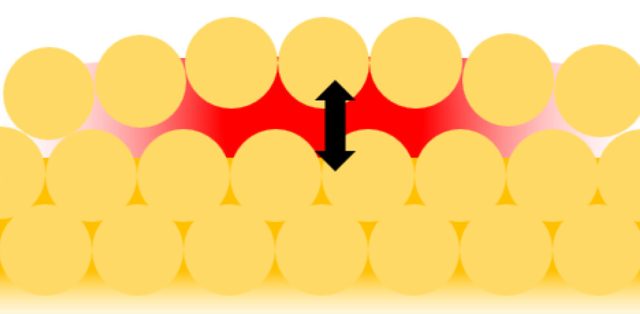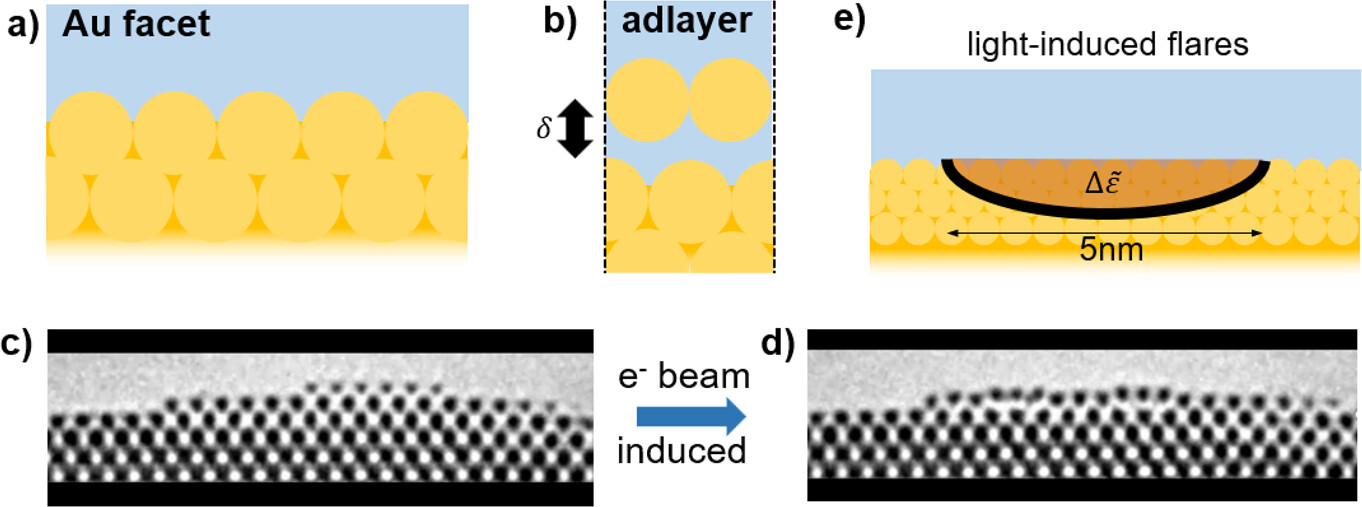Infiltration of light inside Au surfaces
As the top atomic monolayer lifts a few Å off the underlying bulk Au (111), ab initio electronic structure calculations show that for gaps >1.5 Å, visible light squeezes inside the empty slot underneath, giving optical field distributions 2 Å thick, less than the atomic diameter.

Considerable attention has been paid in the past decades to how tightly light can be trapped below its diffraction limit. Exploiting plasmonics and metasurfaces requires metals with free-electron-like properties at the wavelength of interest without interband absorption. Coinage metals such as Au and Ag have been particularly effective at trapping light into nanoscale hot-spots, giving a variety of effects including enhanced Raman scattering (SERS), second-harmonic generation, photocurrents, photocatalysis, and single-emitter strong coupling. Using a plasmonic nanoparticle dimer, the quantum limit for this confinement was ascertained. However, the trapping of light at the metal surfaces of nanoparticles remains subject to numerous questions about the influence of Landau damping, electron spill-out, and tunnelling.
Metallic nanostructures can exhibit atomically flat surfaces, with a prototypical example being the (111) face of gold. It is well-known that on such surfaces, in addition to the bulk-like truncated electronic states, so-called surface states emerge. The surface electronic structure thus consists of two types of electronic states at the Fermi level, exemplifying a two-component electron system.
Pines first suggested that low-energy plasmons with sound-like long-wavelength dispersion resulted from collective charge motion of such a system with two types of electronic carriers. A similar mode was predicted by Chaplik in the Wigner crystallization of a two-dimensional electron gas, whose dispersion transforms into an acoustic one when brought close to a metal surface.
It was later realized that at metal surfaces where a partially occupied quasi-2D surface-state band coexists in the same region of space as an underlying 3D continuum, a well-defined mode with a sound-like dispersion (an acoustic surface plasmon) is formed. This mode was subsequently observed on Be and certain noble metals, as well as in graphene deposited onto metal.

Now, a team of researchers has focused 1 on even smaller size gaps, below the diameter of single atoms. They consider how visible frequency acoustic plasmons are produced by a 2D single-monolayer of Au sitting just above 3D bulk Au, which is very different from traditional surface states. Rather than phenomenological theory, they use a full quantum ab initio treatment, correctly including all levels of (linear) screening to describe the optical response of this extreme “slot” configuration. This infiltration of light inside Au surfaces has implications for many fields, including photocatalysis and compact photodetectors.
The theoretical results show that light can be trapped in subatomic wide slots between a monolayer and bulk gold. The acoustic dispersion revealed is modulated by the slot gap and creates the most tightly confined visible light yet. Interestingly, the researchers show that the slot mode can be surprisingly well described in a classical approximation at separations exceeding 1.5 Å when a true quantum-well state is formed in the Au monolayer at the Fermi level.
The power of these new ab initio calculations is that they include full screening and surface damping effects. The authors suggest a mechanism of how this slot mode might be responsible for the flares observed in inelastic light scattering experiments, feeding intense optical fields into the metal to drive the electronic light emission. This provides intriguing directions for future experiments and theory on the interaction of light and molecule–metal surfaces.
Author: César Tomé López is a science writer and the editor of Mapping Ignorance
Disclaimer: Parts of this article may have been copied verbatim or almost verbatim from the referenced research paper/s.
References
- Jeremy J. Baumberg, Ruben Esteban, Shu Hu, Unai Muniain, Igor V. Silkin, Javier Aizpurua, and Vyacheslav M. Silkin (2023) Quantum Plasmonics in Sub-Atom-Thick Optical Slots Nano Lett. doi: 10.1021/acs.nanolett.3c02537 ↩